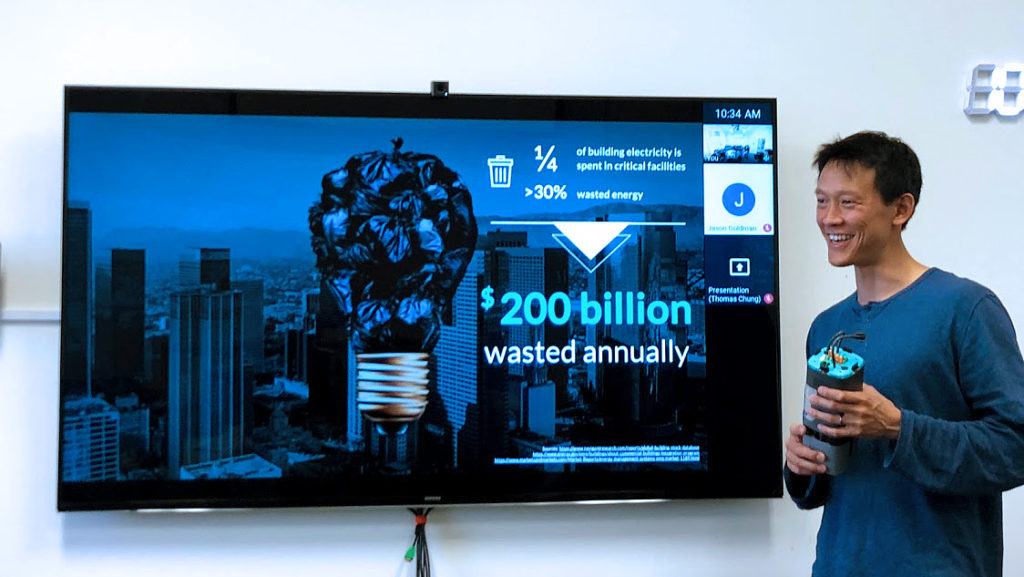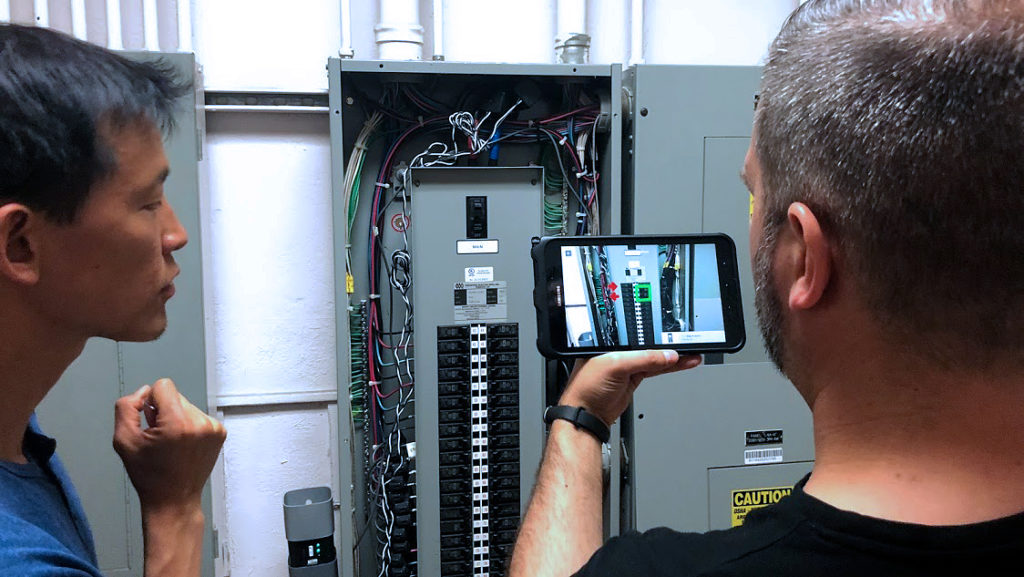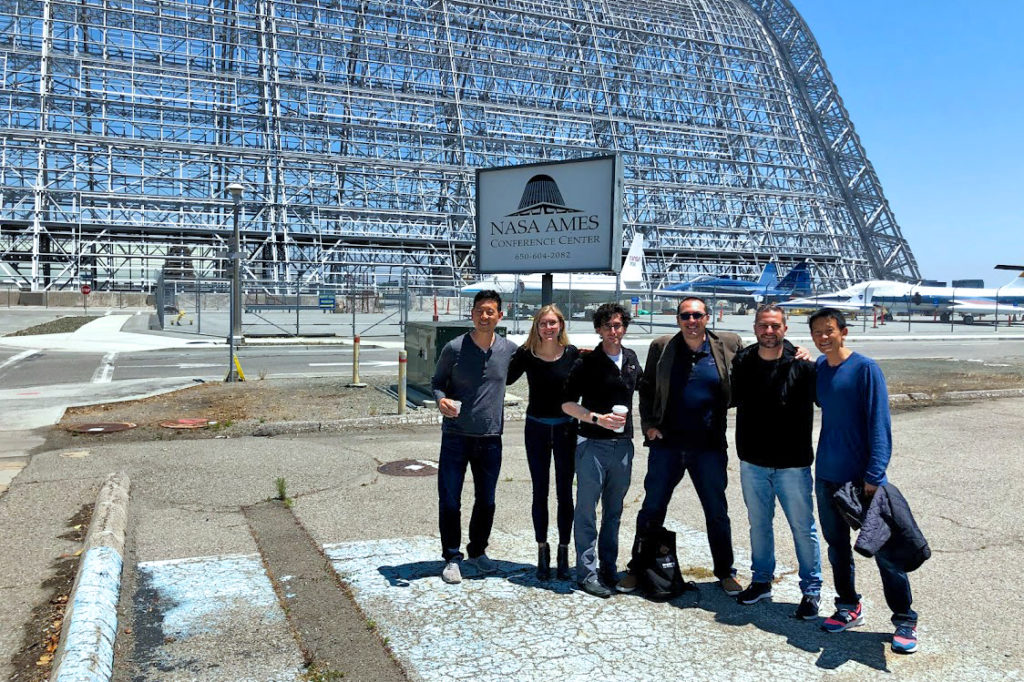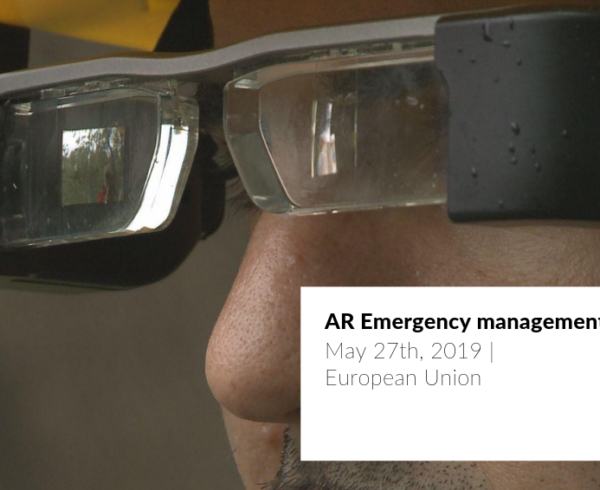

Emerging technologies help industries tackle the climate challenge
JoinPad took part along with DGI in a "Micro-Hackathon" at Nasa Ames Center to test Augmented Reality solution applied to Verdigris' IoT Energy Meter system.
On June 3rd, 2019, three cutting-edge companies specialized in fields ranging from Artificial Intelligence to Augmented Reality and Design Thinking, met at Nasa Ames Research Center in Mountain View, home to many inventions which have become part of our everyday life, to collaborate on an innovative solution for forecasting and management of power consumption within factories and other large facilities. The aim is to use advanced technologies like AI, AR, and IoT to increase the economic and environmental sustainability of buildings and industries 4.0. The three companies are called Verdigris, Design Group Italia (DGI), and JoinPad. Here is how they think technological innovation can change the world.

Emerging technologies help industries tackle the climate challenge
JoinPad took part along with DGI in a "Micro-Hackathon" at Nasa Ames Center to test Augmented Reality solution applied to Verdigris' IoT Energy Meter system.
On June 3rd, 2019, three cutting-edge companies specialized in fields ranging from Artificial Intelligence to Augmented Reality and Design Thinking, met at Nasa Ames Research Center in Mountain View, home to many inventions which have become part of our everyday life, to collaborate on an innovative solution for forecasting and management of power consumption within factories and other large facilities. The aim is to use advanced technologies like AI, AR, and IoT to increase the economic and environmental sustainability of buildings and industries 4.0. The three companies are called Verdigris, Design Group Italia (DGI), and JoinPad. Here is how they think technological innovation can change the world.

Energy-efficient buildings mitigate climate change
As we all are well aware, the climate crisis poses a significant challenge for the whole world. Environmental scientists and the United Nations organization constantly warn us about the irreversible dangers a 2-degree temperature rise would have on the ecological balance. Acid rains, catastrophic hurricanes, melting of glaciers and vast regions across the world on the brink of desertification are now real threats. And climate change is becoming a priority issue for policymakers as well as industrial leaders, which can still mitigate some of the potential disasters by radically transforming the economic system.
Factories and facilities consume a considerable percentage of the energy produced in a country, releasing into the atmosphere carbon pollution which increases the greenhouse effect, namely the warming of Earth’s surface. A Business Insider article revealed in 2015, how commercial, industrial and residential buildings in the USA generate annually around $200 billion energy wastes and 34% of greenhouse gas emissions. The most advanced and sophisticated technological innovations of our century can help to slow down, if not stop global warming, using Big Data, AI, and IoT. Monitoring technologies, low-cost sensors, and the growing digitization of companies can help cut missions while maintaining a high level of efficiency. Within Silicon Valley, Nasa is one of the most high-tech organizations committed on the environmental front. Its centers host highly innovative startups helping them with its technologies and network, if necessary.
Founded in 2012 at Nasa Ames in California, with a mission to sustain and enrich human life through responsive energy intelligence, Verdigris is one of the world’s AI leading startups, focused on optimizing operations and energy consumption in manufacturing, industrial and commercial buildings. Their core technology combines magnetic sensors with machine-learning techniques to detect and predict appliances level energy and waste, providing minutely data and helping their clients save up to 30% energy bill in a completely automated way. Over 40 top tier enterprise clients across 13 countries in manufacturing, distribution, and hospitality use their IoT energy meter and platform to save energy, reduce costs, minimize downtime, and improve sustainability metrics. Companies like ABB, Amazon, Hyatt, and Verizon have already implemented it to achieve industry-leading energy performance.

Thomas Chung, Product Manager at Verdigris
Design Group Italia (DGI), a leading design firm which boasts more than 25 years of experience in energy-related projects, both in the digital and industrial sector, met Verdigris while working together on a project for ABB, multinational corporation leader in the energy field. Thinking Augmented Reality could benefit Verdigris solution, DGI contacted JoinPad, an Augmented Reality company born in Italy with more than ten years of experience in AR, AI, IoT, and design in the industrial sector, and also their long-term partners in business. JoinPad enterprise started in 2011, presenting a pioneering Wearable Augmented Reality application on smart glasses for diagnostics and maintenance of industrial equipment in Las Vegas. Since then, AR has become a critical tool to increase efficiency in any industrial process ranging from MRO (maintenance, repair, overhaul) to logistics and training. Intuitive 3D interfaces provide and allow to share accurate, contextual, real-time information directly in the users’ field of view for fast, outstanding, operational results. Furthermore, many companies that have implemented AR solutions also reduce downtimes by 30% and save costs up to 75% while improving collaboration, productivity, and work quality. The micro-hackathon has been the perfect opportunity to show how AR integrates well with Verdigris’ AI systems to enhance energy management of buildings.
How emerging technologies can tackle the climate challenge
As we all are well aware, the climate crisis poses a significant challenge for the whole world. Environmental scientists and the United Nations organization constantly warn us about the irreversible dangers a 2-degree temperature rise would have on the ecological balance. Acid rains, catastrophic hurricanes, melting of glaciers and vast regions across the world on the brink of desertification are now real threats. And climate change is becoming a priority issue for policymakers as well as industrial leaders, which can still mitigate some of the potential disasters by radically transforming the economic system.
Factories and facilities consume a considerable percentage of the energy produced in a country, releasing into the atmosphere carbon pollution which increases the greenhouse effect, namely the warming of Earth’s surface. A Business Insider article revealed in 2015, how commercial, industrial and residential buildings in the USA generate annually around $200 billion energy wastes and 34% of greenhouse gas emissions. The most advanced and sophisticated technological innovations of our century can help to slow down, if not stop global warming, using Big Data, AI, and IoT. Monitoring technologies, affordable sensor, and the growing digitization of companies can help cut missions while maintaining a high level of efficiency. Within Silicon Valley, Nasa is one of the most high-tech organizations committed on the environmental front. Its centers host highly innovative startups helping them with its technologies and network, if necessary.
Founded in 2012 at Nasa Ames in California, with a mission to sustain and enrich human life through responsive energy intelligence, Verdigris is one of the world’s AI leading startups, focused on optimizing operations and energy consumption in manufacturing, industrial and commercial buildings. Their core technology combines magnetic sensors with machine-learning techniques to detect and predict appliances level energy and waste, providing minutely data and helping their clients save up to 30% energy bill in a completely automated way. Over 40 top tier enterprise clients across 13 countries in manufacturing, distribution, and hospitality use their IoT energy meter and platform to save energy, reduce costs, minimize downtime, and improve sustainability metrics. Companies like ABB, Amazon, Hyatt, and Verizon have already implemented it to achieve industry-leading energy performance.

Thomas Chang, Product Manager at Verdigris
Design Group Italia (DGI), a leading design firm which boasts more than 25 years of experience in energy-related projects, both in the digital and industrial sector, met Verdigris while working together on a project for ABB, multinational corporation leader in the energy field. Thinking Augmented Reality could benefit Verdigris solution, DGI contacted JoinPad, an Augmented Reality company born in Italy with more than ten years of experience in AR, AI, IoT, and design in the industrial sector, and also their long-term partners in business. JoinPad enterprise started in 2011, presenting a pioneering Wearable Augmented Reality application on smart glasses for diagnostics and maintenance of industrial equipment in Las Vegas. Since then, AR has become a critical tool to increase efficiency in any industrial process ranging from MRO (maintenance, repair, overhaul) to logistics and training. Intuitive 3D interfaces provide and allow to share accurate, contextual, real-time information directly in the users’ field of view for fast, outstanding, operational results. Furthermore, many companies that have implemented AR solutions also reduce downtimes by 30% and save costs up to 75% while improving collaboration, productivity, and work quality. The micro-hackathon has been the perfect opportunity to show how AR integrates well with Verdigris’ AI systems to enhance energy management of buildings.
Empowering Verdigris' IoT system installation with Augmented Reality

Mauro Rubin, CEO at JoinPad, and Thomas Chang, Product Manager at Verdigris
The workshop aimed to bring together three highly innovative companies to share their expertise and show how our augmented reality technology can be applied to Verdigris’ IoT sensors, to prototype a new data visualization system built upon DGI’s design thinking approach.
Verdigris develops a ground-breaking sensor that when clamped onto electrical circuits, it starts tracking energy consumption by collecting hundreds of millions more data points than a smart utility meter – every hour. The AI algorithms use this information to create a “virtual physical layer” of data, producing energy forecasts, motor fault sensor streams, and device level energy information.
To install these sensors, Verdigris is exploring the possibility of using Augmented Reality guided instructions to reduce further the operational time, which is already below 30 min, and outpace the competition. Throughout the installation process, electricians refer to instructional videos on youtube as well as an easy manual, both paper and mobile, that step by step guide them on how to position the smart energy meter, making sure to connect all the current transformers (CTs) in the correct way and then attach the CTs chains back to the system itself. After connecting to the system access point with a phone, and to WiFi or LTE, the user has to confirm the connection, as well as voltage and chain validity via the web interface. Lastly, the installation is completed when all system lights are green. At the hackathon, we used our Augmented Reality system, BrainPad, to assist the process more directly and interactively, visualizing instructions through AR interfaces. The integration with the IoT meter proved to be very powerful in helping operators be quick and accurate during the installation. As Verdigris’ team states, “Verdigris prides itself on our product’s ease of install, achieved through intuitive product design, instructional videos, and installation guides. However, we are always on the lookout for ways to optimize time, savings, and the experience of our customers. We linked up to JoinPad’s BrainPad, and its remote video streaming tool, to understand how enriching the installation process with real-time directions, visuals, and indicators of anomaly or success could provide further support to onsite technicians. It was clear to us that the AR tool could offer an additional layer of guidance at a critical part of our customer’s journey.”

Mauro Rubin and Thomas Chang using BrainPad application to visualize in AR Verdigris’ IoT meter instructions.
JoinPad’s BrainPad platform allows any worker with basic computer skills and a CRM to create step-by-step guides in AR for smooth, time-saving assembly service. The user can quickly gather and update relevant information in one place. While working at the electrical panel, he/she can directly access instructions, dashboards, or reports through Augmented Reality-enabled devices such as smartphones, tablets, and smart glasses, without needing a computer. Our customers, such as Siemens, ABB, CommScope, and Alstom have already successfully implemented our solutions to manage and improve operators’ access to work instructions efficiently on electrical station equipment, providing useful information in real time to the operator directly in his/her field of vision.
“It was a pleasure to collaborate with JoinPad and DGI. Our mutual drives to sustain enrich human life through technology solutions that are revolutionizing the built environment fueled the collaboration and exploration of the problem space […]. “We have discussed the potential for AR to improve the installation experience. It was great to be able to setup something quickly and easily to allow us to empower our users.”
Empowering Verdigris' IoT system installation with Augmented Reality

Mauro Rubin, CEO at JoinPad, and Thomas Chang, Product Manager at Verdigris
The workshop aimed to bring together three highly innovative companies to share their expertise and show how our augmented reality technology can be applied to Verdigris’ IoT sensors, to prototype a new data visualization system built upon DGI’s design thinking approach.
Verdigris develops a ground-breaking sensor that when clamped onto electrical circuits, it starts tracking energy consumption by collecting hundreds of millions more data points than a smart utility meter – every hour. The AI algorithms use this information to create a “virtual physical layer” of data, producing energy forecasts, motor fault sensor streams, and device level energy information.
To install these sensors, Verdigris is exploring the possibility of using Augmented Reality guided instructions to reduce further the operational time, which is already below 30 min and outpace the competition. Throughout the installation process, electricians refer to instructional videos on youtube as well as an easy manual, both paper and mobile, that step by step guide them on how to position the smart energy meter, making sure to connect all the current transformers (CTs) in the correct way and then attach the CTs chains back to the system itself. After connecting to the system access point with a phone, and to WiFi or LTE, the user has to confirm the connection, as well as voltage and chain validity via the web interface. Lastly, the installation is completed when all system lights are green. At the hackathon, we used our Augmented Reality system, BrainPad, to assist the process more directly and interactively, visualizing instructions through AR interfaces. The integration with the IoT meter proved to be very powerful in helping operators be quick and accurate during the installation. As Verdigris’ team states, “Verdigris prides itself on our product’s ease of install, achieved through intuitive product design, instructional videos, and installation guides. However, we are always on the lookout for ways to optimize time, savings, and the experience of our customers. We linked up to JoinPad’s BrainPad, and its remote video streaming tool, to understand how enriching the installation process with real-time directions, visuals, and indicators of anomaly or success could provide further support to onsite technicians. It was clear to us that the AR tool could offer an additional layer of guidance at a critical part of our customer’s journey.”

Mauro Rubin and Thomas Chang using BrainPad application to visualize in AR Verdigris’ IoT meter instructions.
JoinPad’s BrainPad platform allows any worker with basic computer skills and a CRM to create step-by-step guides in AR for smooth, time-saving assembly service. The user can quickly gather and update relevant information in one place. While working at the electrical panel, he/she can directly access instructions, dashboards, or reports through Augmented Reality-enabled devices such as smartphones, tablets, and smart glasses, without needing a computer. Our customers, such as Siemens, ABB, CommScope, and Alstom have already successfully implemented our solutions to manage and improve operators’ access to work instructions efficiently on electrical station equipment, providing useful information in real time to the operator directly in his/her field of vision.
“It was a pleasure to collaborate with JoinPad and DGI. Our mutual drives to sustain enrich human life through technology solutions that are revolutionizing the built environment fueled the collaboration and exploration of the problem space […]. “We have discussed the potential for AR to improve the installation experience. It was great to be able to setup something quickly and easily to allow us to empower our users.”
Smart, interconnected buildings, able to monitor energy consumption and waste help mitigate our ecological footprint on the planet, reducing the emission of CO2 into the atmosphere. The faster we act, using state-of-the-art technologies, the more maybe we will be able to save ourselves from far worse natural disasters. In any case, since some environmental changes will be inevitable given that the planet undergoes continuous evolution, we must develop now the right tools to manage limited resources better. As emphasized by our CEO, Mauro Rubin,
“The next few years will be decisive for preserving our planet. Sensors and big data strongly characterize the energy economy. To better understand the world around us, limit our mistakes and evolve as human beings we must use technologies such as AI / AR that improve the knowledge economy and the overall human condition within our societies”.
We are grateful to DGI for organizing the Micro-Hackathon and for connecting us with the incredible team of Verdigris and their fantastic work directed to improve the world through the latest emerging technologies. We loved sharing our ideas and technology with other innovative leaders. Until next time!

From right to left: Thomas Chung (Verdigris), Mauro Rubin (JoinPad), Leandro Agrò (DGI), and Jason Goldman, Leandra Lehmann, Mark Chung (Verdigris)
Smart, interconnected buildings, able to monitor energy consumption and waste help mitigate our ecological footprint on the planet, reducing the emission of CO2 into the atmosphere. The faster we act, using state-of-the-art technologies, the more maybe we will be able to save ourselves from far worse natural disasters. In any case, since some environmental changes will be inevitable given that the planet undergoes continuous evolution, we must develop now the right tools to manage limited resources better. As emphasized by our CEO, Mauro Rubin,
“The next few years will be decisive for preserving our planet. Sensors and big data strongly characterize the energy economy. To better understand the world around us, limit our mistakes and evolve as human beings we must use technologies such as AI / AR that improve the knowledge economy and the overall human condition within our societies”.
We are grateful to DGI for organizing the Micro-Hackathon and for connecting us with the incredible team of Verdigris and their fantastic work directed to improve the world through the latest emerging technologies. We loved sharing our ideas and technology with other innovative leaders. Until next time!

From right to left: Thomas Chung (Verdigris), Mauro Rubin (JoinPad), Leandro Agrò (DGI), and Jason Goldman, Leandra Lehmann, Mark Chung (Verdigris)







Leave a Comment